|
Below is another painting of children by a Song dynasty
artist.
What kinds of goods and services does this
peddler offer? Where do you think the majority of his clients and
customers live?

Li Song (active 1130s-1230s), The
Knickknack Peddler
| SOURCE:
Qin Xiaoyi, ed., Songdai shuhua ceye mingpin tezhan,
Famous Album Leaves of the Sung Dynasty (Taipei:
Guoli Gugong bowuyuan bianji, 1995), pl. 47, p. 177.
Collection of the National Palace Museum, Taipei. Album leaf, ink
and colors on silk, 25.8 x 27.6 cm |
|
For a closer view of some details...
[In the guide, below]
| Below is a closer view
of some details from the album leaf painting, The Knickknack
Peddler. |
| Do you think this is the mother
of the children? What do you think are the relative ages
of the children represented?
Is there anything in the appearance or behavior of the
children that helps you identify their social class?
| SOURCE:
Qin Xiaoyi, ed., Songdai shuhua ceye mingpin tezhan,
Famous Album Leaves of the Sung Dynasty (Taipei:
Guoli Gugong bowuyuan bianji weiyuanhui, 1995), pl. 47a,
p. 178. Collection of the National Palace Museum,
Taipei. Album leaf, ink
and light colors on silk, 25.8 x 27.6 cm.
|
|
 |
| HINT:
Compare below the representation of children in The
Knickknack Peddler to those in Palace Children Playing.
Do the children seem to have more in common than they
have distinguishing traits (both in terms of physical
appearance and behavior)? Could you switch
children between the two paintings? Why or why
not? If you are struck by the differences, do you
think that the painter is depicting people in
stereotyped terms, or do you think he is accurately
representing class differences? |
|
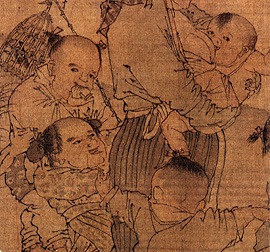
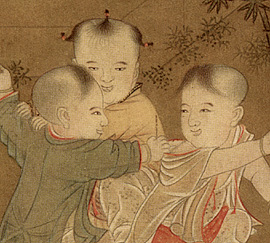
|
| Below is a detail of the basket on
the left hand side of the painting. |
 |
Can you determine by examining the goods
that the peddler carries in stock who might be his most frequent
customers?
Of the objects that you can identify, do the majority seem
to be of a certain type or function?
| SOURCE:
LQin Xiaoyi, ed., Songdai shuhua ceye mingpin tezhan,
Famous Album Leaves of the Sung Dynasty (Taipei:
Guoli Gugong bowuyuan bianji weiyuanhui, 1995), pl. 47b,
p. 178. Collection of the National Palace Museum,
Taipei. Album leaf, ink
and light colors on silk, 25.8 x 27.6 cm |
|
 |
Aside from selling toys and small household
items, itinerant merchants also offered professional services.
How do you think these peddlers would have made these
services known to potential customers?
A sign at the bottom of the basket on the right (detail seen
below), for instance, advertises this peddler's proficiency at
doctoring cattle, horses, and small children (in that order).

Note the necklaces the peddler is wearing around his neck;
these advertise special skills as well.
What services do you think these represent?
| SOURCE:
Qin Xiaoyi, ed., Songdai shuhua ceye mingpin tezhan,
Famous Album Leaves of the Sung Dynasty (Taipei:
Guoli Gugong bowuyuan bianji weiyuanhui, 1995), pl. 47c,
p. 179. Collection of the National Palace Museum,
Taipei. Album leaf, ink
and light colors on silk, 25.8 x 27.6 cm |
| ANSWER:
The
peddler wears two strings of advertisements around his
neck; one, with images of eyes painted on disks,
proclaims his expertise as an eye doctor, while the
other necklace, strung with teeth, indicates that he
provides dental services. |
|
|

 In Song times, domestic life became an increasingly frequent subject
not only for poetry and drama but for paintings as well.
Under-represented in official written records, the lives and customs of
people of all classes, were depicted in great detail in the visual arts.
Women and children in particular became a focus for several academy
artists who specialized in these genres. In this section we will
look at paintings portraying people in the private sphere of family and
friends. In many cases, the artists' sensitive treatment of
personality and character, as well as careful attention to, say, the
material distinctions between fine, elegant robes and the coarse
textures of peasants' everyday clothing, gives useful data about
how social class and status were expressed visually and the dynamics of
social interactions.
In Song times, domestic life became an increasingly frequent subject
not only for poetry and drama but for paintings as well.
Under-represented in official written records, the lives and customs of
people of all classes, were depicted in great detail in the visual arts.
Women and children in particular became a focus for several academy
artists who specialized in these genres. In this section we will
look at paintings portraying people in the private sphere of family and
friends. In many cases, the artists' sensitive treatment of
personality and character, as well as careful attention to, say, the
material distinctions between fine, elegant robes and the coarse
textures of peasants' everyday clothing, gives useful data about
how social class and status were expressed visually and the dynamics of
social interactions. Paintings
of children were popular at court and became a specialty of a handful of
artists. This subject matter was considered auspicious, and was a
favorite theme for New Year's pictures given as gifts.
Paintings
of children were popular at court and became a specialty of a handful of
artists. This subject matter was considered auspicious, and was a
favorite theme for New Year's pictures given as gifts. 



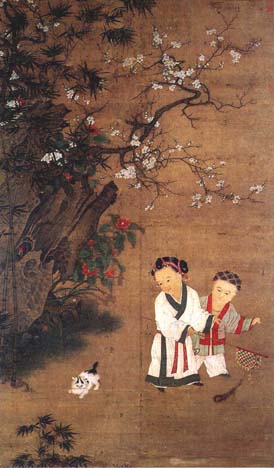

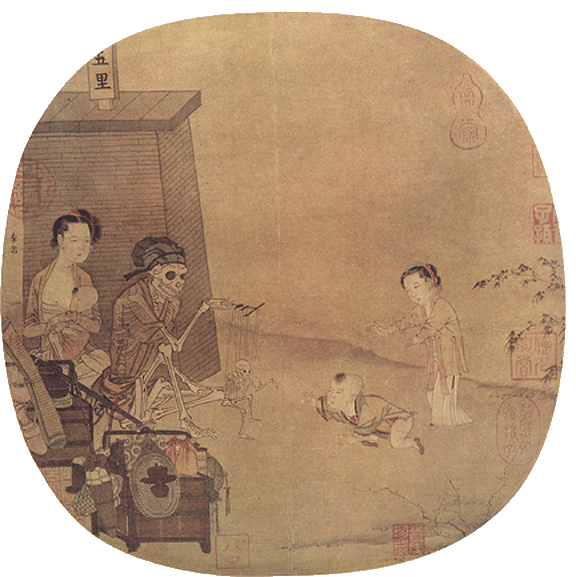








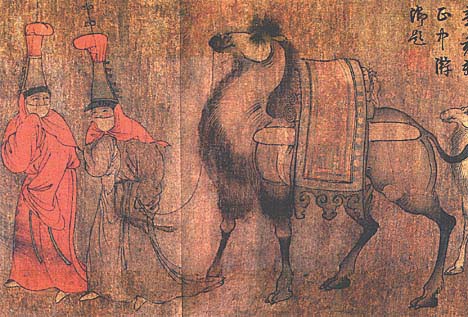
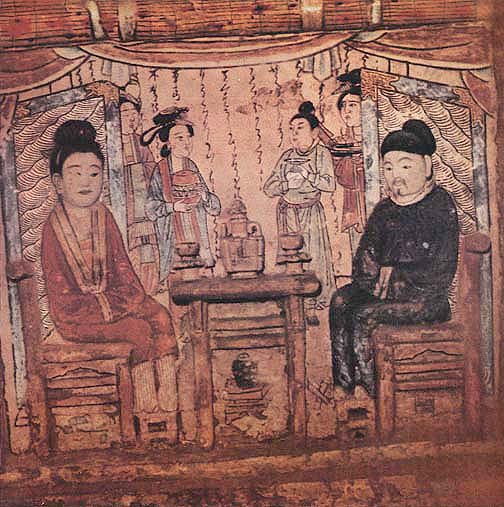 Funerary
art, like this painting from the wall of a tomb, naturally idealizes its
subject.
Funerary
art, like this painting from the wall of a tomb, naturally idealizes its
subject.

